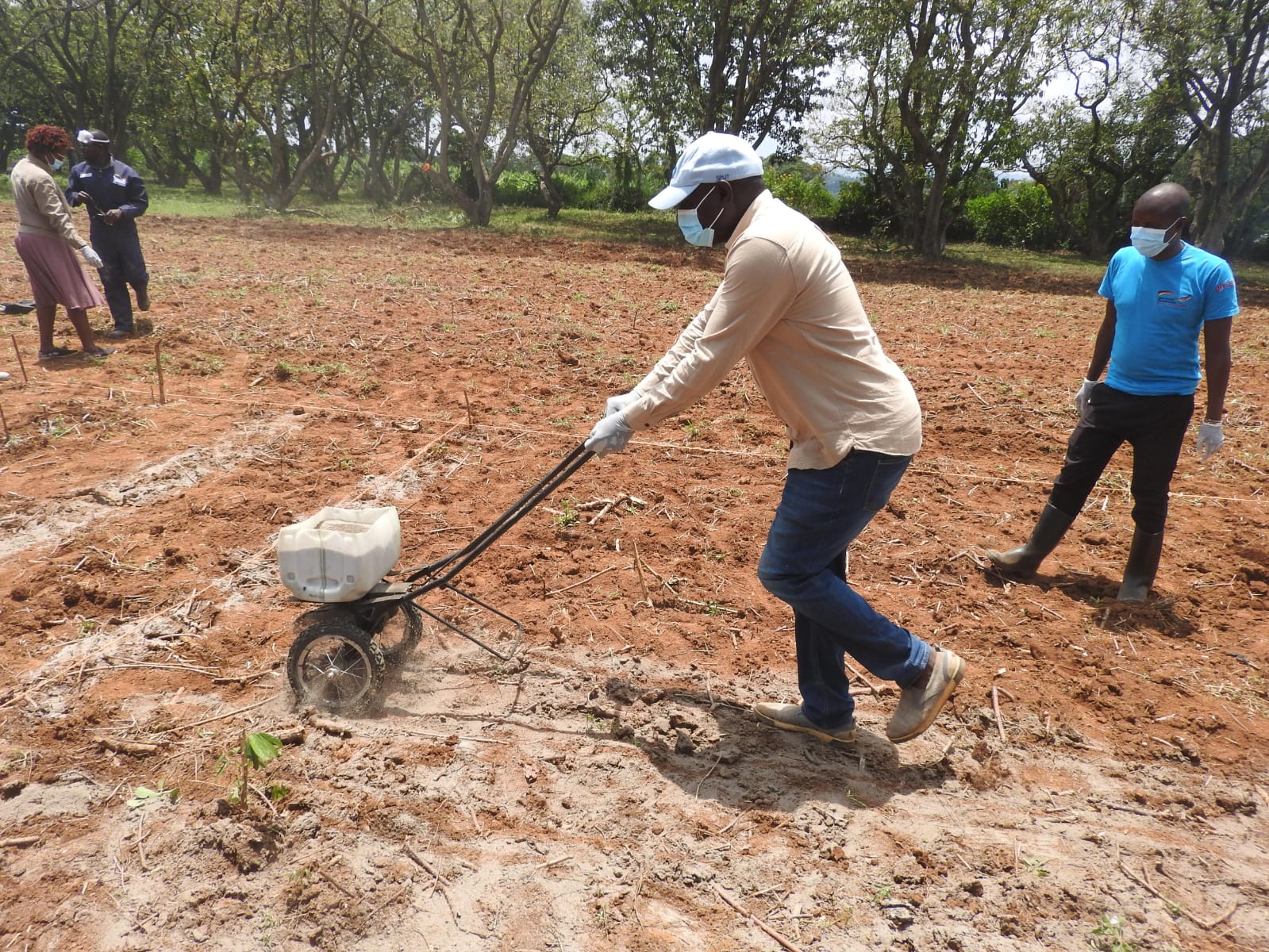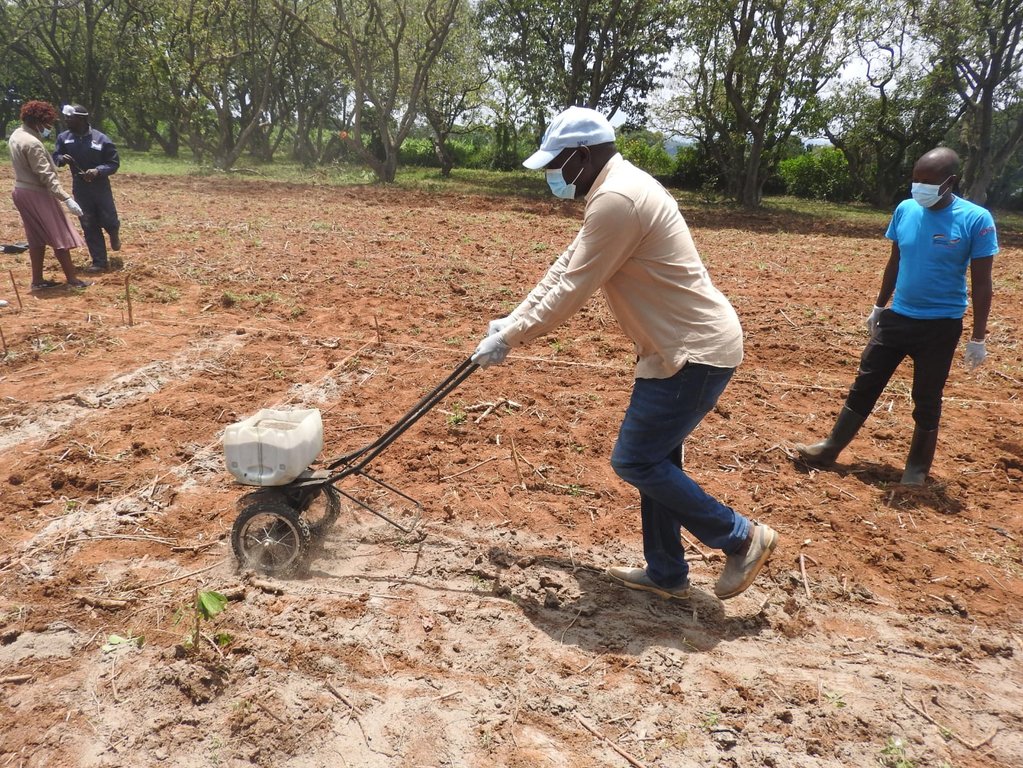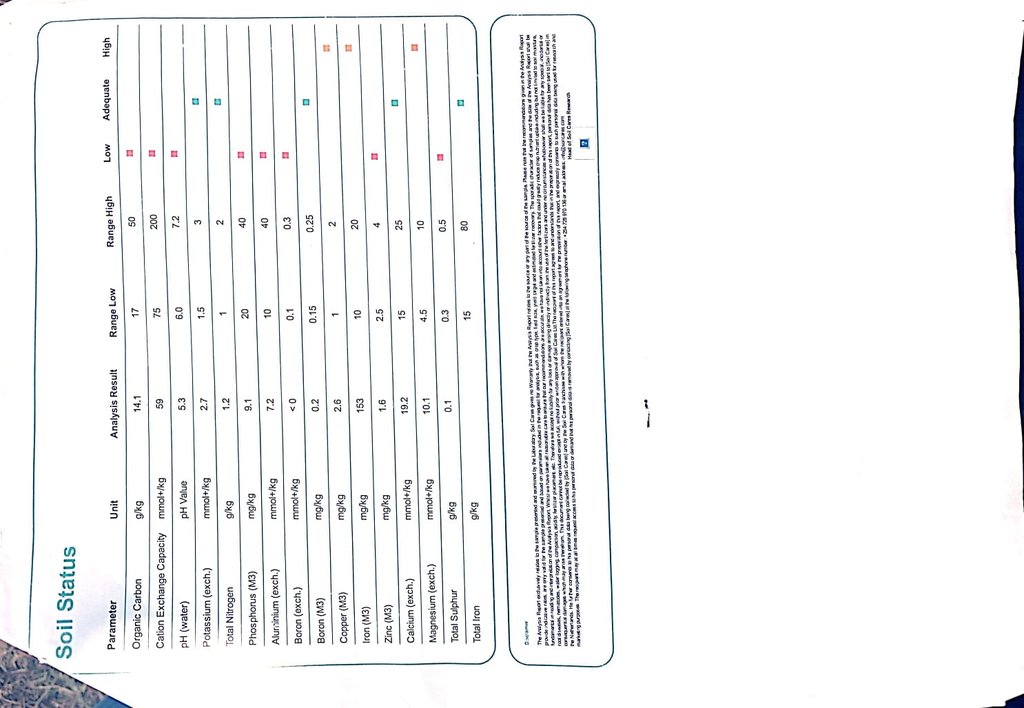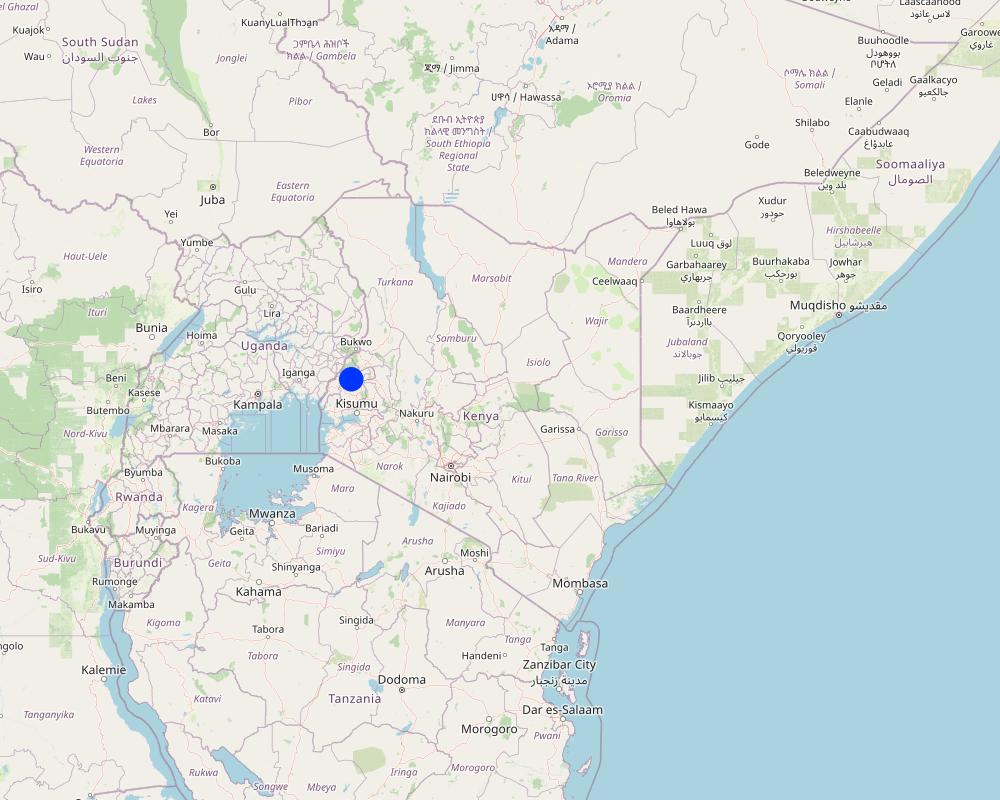Lime application to acid soils [Kenya]
- Creation:
- Update:
- Compiler: William Akwanyi
- Editors: JUSTINE OTSYULA, Innocent Faith, Noel Templer, Tabitha Nekesa, Ahmadou Gaye, Siagbé Golli
- Reviewers: William Critchley, Rima Mekdaschi Studer, Sally Bunning
technologies_6702 - Kenya
View sections
Expand all Collapse all1. General information
1.2 Contact details of resource persons and institutions involved in the assessment and documentation of the Technology
Key resource person(s)
land user:
Wekesa Maryann Nanjala
Lukina Women Group - Welthungerhilfe farmer group
Kenya
SLM specialist:
SLM specialist:
1.3 Conditions regarding the use of data documented through WOCAT
The compiler and key resource person(s) accept the conditions regarding the use of data documented through WOCAT:
Yes
1.4 Declaration on sustainability of the described Technology
Is the Technology described here problematic with regard to land degradation, so that it cannot be declared a sustainable land management technology?
No
Comments:
There have been no adverse effects on the environment in the area since lime was applied to the demo site in 2022.
1.5 Reference to Questionnaire(s) on SLM Approaches (documented using WOCAT)
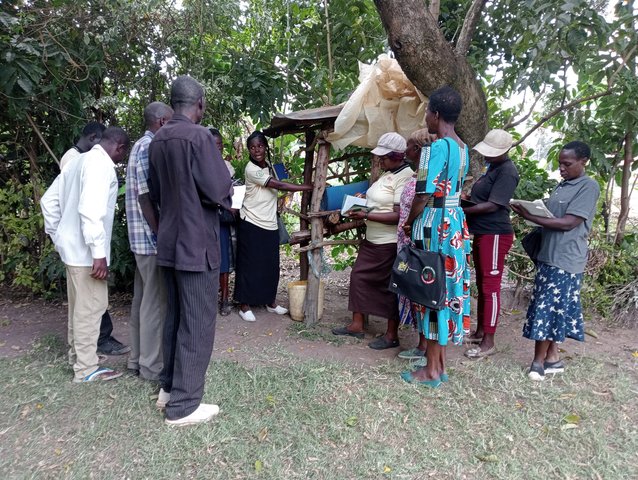
Community Resource Persons (CRP) in agricultural extension [Kenya]
Community Resource Persons (CRP) form a farmer-to-farmer learning approach that bridges the gap in agricultural extension, increases farmers' access to agricultural information (SLM knowledge), and increases the adoption of SLM practices.
- Compiler: William Akwanyi
2. Description of the SLM Technology
2.1 Short description of the Technology
Definition of the Technology:
Lime application is a rapid way to treat soil acidity and improve productivity.
2.2 Detailed description of the Technology
Description:
Liming is the application of soil conditioners, including marl, chalk, limestone, burnt lime, or hydrated lime to the soil to raise its pH; thus, reduce its acidity. Calcium (Ca) and magnesium (Mg)-rich materials are the most used – the Ca or Mg increase the base saturation in the soil hence neutralizing soil acidity that is often caused by the effects of acids from nitrogen (N) fertilizer, slurry, and high rainfall. Liming improves soil fertility by increasing the activity of beneficial earthworms and improving soil structure. It is a source of Ca, and by raising the pH of soils it increases uptake of plant nutrients.
The soil must be tested to determine its pH level. Lime should be applied to soils with pH levels below 5.0, but especially to soils with pH below 4.0 which are very acidic. High concentrations of acids decrease the availability of plant nutrients, especially phosphorous (P) and molybdenum (Mo) and increase the toxic effect of aluminium (Al) and manganese (Mn). In addition, acidity causes some plant nutrients to be leached below the plant rooting zone.
A farmer must wear protective clothing, including face masks, goggles, gumboots, gloves, and an apron before working with lime. The best time to apply agricultural lime to any piece of land is during the dry season. The lime must be covered with soil immediately after application to prevent loss through evaporation, since it is highly volatile. If lime has to be applied during the rainy season, the farmer must apply the lime just before it starts to rain so that the rainwater can leach the lime into the soil. Agricultural lime can be applied in three ways:
a) Broadcasting with a spreader. The land must be ploughed immediately to cover the lime and to prevent loss through evaporation.
b) Band method: Lime is applied between crops if it was not applied before land preparation. The lime must also be covered with soil immediately.
c) Spot method: Lime is applied at the base of the crop (similar to top dressing). Similarly, the lime must also be covered with soil immediately.
Farmers like agricultural lime because it improves soil structure and larger particles are formed in a process called flocculation. In addition, lime binds the larger particles of humus producing a good crumb structure. This improves soil drainage by creating more air spaces. Thus, the soil become easier to cultivate and plant root growth is facilitated. One acre (0.4 ha) of land with a pH of below 4.0 requires 300-350 kgs of lime; a pH of between 4.0 and 5.0, requires 200–250 kgs.
2.3 Photos of the Technology
2.5 Country/ region/ locations where the Technology has been applied and which are covered by this assessment
Country:
Kenya
Region/ State/ Province:
Bungoma County in Western Kenya
Further specification of location:
Luuya Bwake Ward, Kabuchai Sub-county
Specify the spread of the Technology:
- evenly spread over an area
If precise area is not known, indicate approximate area covered:
- < 0.1 km2 (10 ha)
Is/are the technology site(s) located in a permanently protected area?
No
Comments:
There are not protected areas in the area where the technology is implemented.
Map
×2.6 Date of implementation
Indicate year of implementation:
2022
2.7 Introduction of the Technology
Specify how the Technology was introduced:
- through projects/ external interventions
Comments (type of project, etc.):
Introduced by the ProSoil Project under a Soil Health Programme.
3. Classification of the SLM Technology
3.1 Main purpose(s) of the Technology
- improve production
- reduce, prevent, restore land degradation
- preserve/ improve biodiversity
- create beneficial economic impact
3.2 Current land use type(s) where the Technology is applied
Land use mixed within the same land unit:
Yes
Specify mixed land use (crops/ grazing/ trees):
- Agro-silvopastoralism

Cropland
- Annual cropping
- Perennial (non-woody) cropping
- Tree and shrub cropping
Annual cropping - Specify crops:
- oilseed crops - groundnuts
- cereals - maize
- cereals - millet
- legumes and pulses - lentils
- legumes and pulses - beans
- root/tuber crops - sweet potatoes, yams, taro/cocoyam, other
Annual cropping system:
Maize/sorghum/millet intercropped with legume
Perennial (non-woody) cropping - Specify crops:
- banana/plantain/abaca
- fodder crops - grasses
Tree and shrub cropping - Specify crops:
- avocado
- fruits, other
- mango, mangosteen, guava
- papaya
Number of growing seasons per year:
- 2
Specify:
Crops are grown during the long and short rain seasons.
Is intercropping practiced?
Yes
If yes, specify which crops are intercropped:
Maize/ millet and legumes (beans) or groundnuts.
Is crop rotation practiced?
Yes
If yes, specify:
Part of the land is left fallow during the short rains.

Grazing land
Intensive grazing/ fodder production:
- Cut-and-carry/ zero grazing
- Improved pastures
Animal type:
- cattle - dairy and beef (e.g. zebu)
- poultry
Is integrated crop-livestock management practiced?
Yes
If yes, specify:
Manure from livestock is applied to the crop field.
Products and services:
- economic security, investment prestige
- milk
- manure as fertilizer/ energy production
- eggs
- meat
Species:
cattle - dairy and beef (e.g. zebu)
Count:
3
Species:
poultry
Count:
10
3.3 Has land use changed due to the implementation of the Technology?
Has land use changed due to the implementation of the Technology?
- No (Continue with question 3.4)
3.4 Water supply
Water supply for the land on which the Technology is applied:
- mixed rainfed-irrigated
Comments:
There is drip irrigation using plastic bottle for bananas.
3.5 SLM group to which the Technology belongs
- integrated soil fertility management
3.6 SLM measures comprising the Technology

agronomic measures
- A2: Organic matter/ soil fertility
- A3: Soil surface treatment

management measures
- M4: Major change in timing of activities
- M7: Others
3.7 Main types of land degradation addressed by the Technology

chemical soil deterioration
- Cn: fertility decline and reduced organic matter content (not caused by erosion)
- Ca: acidification
- Cp: soil pollution

physical soil deterioration
- Ps: subsidence of organic soils, settling of soil

biological degradation
- Bs: quality and species composition/ diversity decline
- Bl: loss of soil life
3.8 Prevention, reduction, or restoration of land degradation
Specify the goal of the Technology with regard to land degradation:
- restore/ rehabilitate severely degraded land
4. Technical specifications, implementation activities, inputs, and costs
4.1 Technical drawing of the Technology
Technical specifications (related to technical drawing):
A lime spreader
Author:
Justine Otsyula
Date:
09/02/2022
Technical specifications (related to technical drawing):
A bag of lime
Author:
Justine Otsyula
Date:
09/02/2022
4.2 General information regarding the calculation of inputs and costs
Specify how costs and inputs were calculated:
- per Technology area
Indicate size and area unit:
0.4 ha
other/ national currency (specify):
KES
If relevant, indicate exchange rate from USD to local currency (e.g. 1 USD = 79.9 Brazilian Real): 1 USD =:
124.21352
4.3 Establishment activities
| Activity | Timing (season) | |
|---|---|---|
| 1. | Soil testing | In preparation for liming |
| 2. | Lime acquisition | In preparation for liming |
| 3. | Acquisition of personal protective equipment clothing (PPE) | In preparation for liming |
| 4. | Lime application | Before soil disturbance through ploughing/ before rains |
| 5. | Ploughing/ covering lime | After lime application |
4.4 Costs and inputs needed for establishment
| Specify input | Unit | Quantity | Costs per Unit | Total costs per input | % of costs borne by land users | |
|---|---|---|---|---|---|---|
| Labour | Lime application | Man-days | 2.0 | 300.0 | 600.0 | 100.0 |
| Labour | Ploughing/ covering lime | Man-days | 15.0 | 300.0 | 4500.0 | 100.0 |
| Equipment | PPE | Set | 1.0 | 3000.0 | 3000.0 | 100.0 |
| Fertilizers and biocides | Lime | 50 kgs bag | 20.0 | 300.0 | 6000.0 | 100.0 |
| Other | Soil testing | Sample | 1.0 | 800.0 | 800.0 | 100.0 |
| Total costs for establishment of the Technology | 14900.0 | |||||
| Total costs for establishment of the Technology in USD | 119.95 | |||||
4.5 Maintenance/ recurrent activities
| Activity | Timing/ frequency | |
|---|---|---|
| 1. | Regular testing | Every 3 years, after 6 months if all required lime was not applied |
| 2. | Lime acquisition | In preparation for liming |
| 3. | Reapplication | Dependent on soil test results |
| 4. | Ploughing/ covering lime | After lime application |
Comments:
No maintenance has been done so far.
4.6 Costs and inputs needed for maintenance/ recurrent activities (per year)
| Specify input | Unit | Quantity | Costs per Unit | Total costs per input | % of costs borne by land users | |
|---|---|---|---|---|---|---|
| Labour | Lime application | Man- days | 2.0 | 300.0 | 600.0 | 100.0 |
| Labour | Ploughing/ covering lime | Man- days | 15.0 | 300.0 | 4500.0 | 100.0 |
| Equipment | PPE | Set | 1.0 | 3000.0 | 3000.0 | 100.0 |
| Fertilizers and biocides | Lime | 50 Kg bags | 3.0 | 300.0 | 900.0 | 100.0 |
| Other | Soil testing | Sample | 1.0 | 800.0 | 800.0 | 100.0 |
| Total costs for maintenance of the Technology | 9800.0 | |||||
| Total costs for maintenance of the Technology in USD | 78.9 | |||||
Comments:
No maintenance has been done so far. The indicated costs are for information purposes. Reapplication is dependent on recommendations of soil testing. It is assumed that reapplication will require a smaller amount of lime than the initial application.
4.7 Most important factors affecting the costs
Describe the most determinate factors affecting the costs:
Rate of man-days and costs vary from one place to another, farmer to farmer, and with type of work. Costs for maintenance are subject to change with time.
Exchange rate for February 2023, source: European Commission/ InfoEuro online at https://commission.europa.eu/funding-tenders/procedures-guidelines-tenders/information-contractors-and-beneficiaries/exchange-rate-inforeuro_en
5. Natural and human environment
5.1 Climate
Annual rainfall
- < 250 mm
- 251-500 mm
- 501-750 mm
- 751-1,000 mm
- 1,001-1,500 mm
- 1,501-2,000 mm
- 2,001-3,000 mm
- 3,001-4,000 mm
- > 4,000 mm
Specify average annual rainfall (if known), in mm:
1200.00
Specifications/ comments on rainfall:
Monthly rainfall variability is high with some months such as January recording less than 5 mm of total rainfall.
Indicate the name of the reference meteorological station considered:
Bungoma Meteorological Station
Agro-climatic zone
- humid
The climate in the area favours most agricultural activities.
5.2 Topography
Slopes on average:
- flat (0-2%)
- gentle (3-5%)
- moderate (6-10%)
- rolling (11-15%)
- hilly (16-30%)
- steep (31-60%)
- very steep (>60%)
Landforms:
- plateau/plains
- ridges
- mountain slopes
- hill slopes
- footslopes
- valley floors
Altitudinal zone:
- 0-100 m a.s.l.
- 101-500 m a.s.l.
- 501-1,000 m a.s.l.
- 1,001-1,500 m a.s.l.
- 1,501-2,000 m a.s.l.
- 2,001-2,500 m a.s.l.
- 2,501-3,000 m a.s.l.
- 3,001-4,000 m a.s.l.
- > 4,000 m a.s.l.
Indicate if the Technology is specifically applied in:
- not relevant
Comments and further specifications on topography:
The farm is located at an area that is higher in altitude compared to other areas in the larger area. The farmer's field lies at an elevation of 1,505 m above sea level.
5.3 Soils
Soil depth on average:
- very shallow (0-20 cm)
- shallow (21-50 cm)
- moderately deep (51-80 cm)
- deep (81-120 cm)
- very deep (> 120 cm)
Soil texture (topsoil):
- medium (loamy, silty)
Soil texture (> 20 cm below surface):
- medium (loamy, silty)
Topsoil organic matter:
- medium (1-3%)
If available, attach full soil description or specify the available information, e.g. soil type, soil PH/ acidity, Cation Exchange Capacity, nitrogen, salinity etc.
pH = 5.3, Cation Exchange Capacity = 59 mmol+/kg, nitogen = 9 g/kg, SOC = 14.1 g/kg
5.4 Water availability and quality
Ground water table:
5-50 m
Availability of surface water:
good
Water quality (untreated):
poor drinking water (treatment required)
Water quality refers to:
both ground and surface water
Is water salinity a problem?
No
Is flooding of the area occurring?
No
Comments and further specifications on water quality and quantity:
There are several boreholes in the area and according to interviews with some borehole owners, the depths are not more than 50 metres.
5.5 Biodiversity
Species diversity:
- medium
Habitat diversity:
- medium
Comments and further specifications on biodiversity:
Most farms are under crops and trees; hence, the area has high agrobiodiversity.
5.6 Characteristics of land users applying the Technology
Sedentary or nomadic:
- Sedentary
Market orientation of production system:
- mixed (subsistence/ commercial)
Off-farm income:
- > 50% of all income
Relative level of wealth:
- average
Individuals or groups:
- individual/ household
- groups/ community
Level of mechanization:
- manual work
- animal traction
Gender:
- women
- men
Age of land users:
- youth
- middle-aged
- elderly
5.7 Average area of land used by land users applying the Technology
- < 0.5 ha
- 0.5-1 ha
- 1-2 ha
- 2-5 ha
- 5-15 ha
- 15-50 ha
- 50-100 ha
- 100-500 ha
- 500-1,000 ha
- 1,000-10,000 ha
- > 10,000 ha
Is this considered small-, medium- or large-scale (referring to local context)?
- medium-scale
5.8 Land ownership, land use rights, and water use rights
Land ownership:
- individual, not titled
- individual, titled
Land use rights:
- individual
Water use rights:
- communal (organized)
- individual
Are land use rights based on a traditional legal system?
No
5.9 Access to services and infrastructure
health:
- poor
- moderate
- good
education:
- poor
- moderate
- good
technical assistance:
- poor
- moderate
- good
employment (e.g. off-farm):
- poor
- moderate
- good
markets:
- poor
- moderate
- good
energy:
- poor
- moderate
- good
roads and transport:
- poor
- moderate
- good
drinking water and sanitation:
- poor
- moderate
- good
financial services:
- poor
- moderate
- good
Comments:
The above rating varies from one village to the other.
6. Impacts and concluding statements
6.1 On-site impacts the Technology has shown
Socio-economic impacts
Production
crop production
Quantity before SLM:
3
Quantity after SLM:
9
Comments/ specify:
Quantity refers to the number of 90 Kg bags of maize produced per acre.
crop quality
Comments/ specify:
Not easy for the farmers to quantify.
fodder production
Quantity before SLM:
6
Quantity after SLM:
10
Comments/ specify:
Quality refers to the number of bunches/ loads of harvested napier grass.
fodder quality
Comments/ specify:
Not easy for the farmers to quantify.
risk of production failure
Quantity before SLM:
50
Quantity after SLM:
40
Comments/ specify:
Quantity refers to the percentage probability of the crop failing to do well.
land management
Comments/ specify:
Not easy for the farmers to quantify but the farmer says that it is easier to work on the soil since lime was applied.
Income and costs
expenses on agricultural inputs
Quantity before SLM:
3,500
Quantity after SLM:
6,000
Comments/ specify:
The farmer used to buy 1 bag of 50 Kg DAP for the 1 acre. The test results recommended that she applies 2.5 bags of 50 Kg NPK. This increased the expenditure on fertilizer.
farm income
Quantity before SLM:
6,000
Quantity after SLM:
15,000
Comments/ specify:
She used to sell 2 bags of 50Kgs of maize at KES 3,000/- but after improved production she was able to sell 5 bags at the same price.
workload
Comments/ specify:
Not easy to quantify but the work has slightly increased due to the need to apply lime.
Socio-cultural impacts
food security/ self-sufficiency
Quantity before SLM:
2
Quantity after SLM:
1
Comments/ specify:
Quantity refers to the number of months in a year when there is total lack of food in the house, and the farmer has to buy all the food required in the house.
SLM/ land degradation knowledge
Quantity before SLM:
30
Quantity after SLM:
70
Comments/ specify:
Quantity refers to the estimated percentage of knowledge in SLM/ land management.
Ecological impacts
Soil
acidity
Quantity before SLM:
5.3
Quantity after SLM:
Not known
Comments/ specify:
The has not done a confirmatory test but it is clear that the pH has reduced due to the improved production.
6.2 Off-site impacts the Technology has shown
Specify assessment of off-site impacts (measurements):
None noted
6.3 Exposure and sensitivity of the Technology to gradual climate change and climate-related extremes/ disasters (as perceived by land users)
Gradual climate change
Gradual climate change
| Season | increase or decrease | How does the Technology cope with it? | |
|---|---|---|---|
| annual temperature | increase | well |
6.4 Cost-benefit analysis
How do the benefits compare with the establishment costs (from land users’ perspective)?
Short-term returns:
very positive
Long-term returns:
very positive
How do the benefits compare with the maintenance/ recurrent costs (from land users' perspective)?
Short-term returns:
very positive
Long-term returns:
very positive
6.5 Adoption of the Technology
- single cases/ experimental
If available, quantify (no. of households and/ or area covered):
About 30 households
Comments:
Still in demonstration stage.
6.6 Adaptation
Has the Technology been modified recently to adapt to changing conditions?
No
6.7 Strengths/ advantages/ opportunities of the Technology
| Strengths/ advantages/ opportunities in the land user’s view |
|---|
| Improves crop yields. |
| Efficiency in use of fertilizers. |
| Strengths/ advantages/ opportunities in the compiler’s or other key resource person’s view |
|---|
| Makes it easier to work on land. |
6.8 Weaknesses/ disadvantages/ risks of the Technology and ways of overcoming them
| Weaknesses/ disadvantages/ risks in the land user’s view | How can they be overcome? |
|---|---|
| High cost of PPE. | The farmer should budget for and plan to buy the PPE early before time of application. |
| Weaknesses/ disadvantages/ risks in the compiler’s or other key resource person’s view | How can they be overcome? |
|---|---|
| Limitation in accessing soil testing facilities/ services. | Create awareness about and link farmers to existing soil testing facilities/ services. |
7. References and links
7.1 Methods/ sources of information
- field visits, field surveys
Visit to demo farms.
- interviews with land users
Interview with members of Lukina Women Group. Follow-up questions on phone with the contact person, Maryann Wekesa.
- interviews with SLM specialists/ experts
ProSoil team and project implementers from WHH consulted.
When were the data compiled (in the field)?
14/02/2023
7.2 References to available publications
Title, author, year, ISBN:
Liming effects on soil pH and crop yield depend on lime material type, application method and rate, and crop species: a global meta-analysis
Available from where? Costs?
Free download at https://www.researchgate.net/publication/327188728_Liming_effects_on_soil_pH_and_crop_yield_depend_on_lime_material_type_application_method_and_rate_and_crop_species_a_global_meta-analysis
7.3 Links to relevant online information
Title/ description:
Soil Acidity and Liming
URL:
https://www.ctahr.hawaii.edu/oc/freepubs/pdf/pnm10.pdf
Title/ description:
Bungoma County Integrated Development Plan, 2018-2022
URL:
Free download at https://www.devolution.go.ke/wp-content/uploads/2020/02/Bungoma-CIDP-2018-2022.pdf
7.4 General comments
1. Provide a function to be able to link the documented SLM to similar work that has been documented in other databases e.g., LandPortal, etc.
2. Some of the impacts (section 6) cannot be quantified.
Links and modules
Expand all Collapse allLinks

Community Resource Persons (CRP) in agricultural extension [Kenya]
Community Resource Persons (CRP) form a farmer-to-farmer learning approach that bridges the gap in agricultural extension, increases farmers' access to agricultural information (SLM knowledge), and increases the adoption of SLM practices.
- Compiler: William Akwanyi
Modules
No modules


